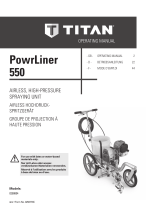
PAFS 550 A1
■ 6 │ GB│IE
Additional safety instructions
RISK OF EXPLOSION AND FIRE!
► Make sure there are no ignition sources in the
vicinity. There is a risk of explosion due to the
potential formation of an explosive atmos-
phere in combination with ignition sources
(e.g. by electrostatic discharge, electric
sparks, hot surfaces)!
■RISK OF INJURY! DUE TO MISUSE! Do not
point the appliance towards people or animals.
■RISK OF EXPLOSION/FIRE! SMOKING
PROHIBITED! Do not cause any sparks or
ignite a naked flame. Make sure there are no
ignition sources in the vicinity, such as open
fires, smoking cigarettes, cigars and tobacco
pipes, sparks, glowing wires, hot surfaces, etc.
WARNING!
► Keep your distance from the nozzle tip!
■Do not spray yourself, other people or ani-
mals. Keep your hands and other body parts
out of the spray jet. If the spray jet pierces your
skin, seek medical assistance immediately. The
sprayed material can even penetrate through a
glove and into the skin and thus into your body.
■Do not treat an injection wound as a simple
cut. A high-pressure jet can inject toxins into
the body and cause serious injuries (e.g.
necrosis, loss of limbs). In the event of a chemi-
cal penetration of the skin, seek medical assis-
tance immediately.
■ Before each use, the following points must be
observed in accordance with the operating
instructions:
1) Do not use an appliance if it is faulty.
2) Secure the hand spray gun against acciden-
tal activation using the safety catch on the
trigger.
3) Ensure earthing – The connection must be
made via a properly earthed safety socket
(Schuko).
4) Check the maximum permissible operating
pressure of the high-pressure hose and spray
gun.
5) Check all connections for leaks.
■ Strictly follow the instructions on regular cleaning
and maintenance of the appliance. Observe the
following rules before carrying out any work on
the appliance and at every work break:
1) Depressurise the spray gun and the
high-pressure hose.
2) Secure the hand spray gun against acciden-
tal activation using the safety catch on the
trigger.
3) Switch off the appliance.
■Do not use the appliance in areas that fall
under the explosion protection ordinance.
■Keep your work area clean, well lit and free
of paint and solvent containers, cloths and
other inflammable materials. Possible risk of
spontaneous combustion. Make sure you have
functional fire extinguishers available at all
times.
■Do not spray or clean with materials whose
ignition point is lower than 21°C. Use water-
based materials, non-volatile hydrocarbons
or similar materials. The evaporation of volatile
solvents will cause an explosive environment.
■Do not spray near ignition sources such as
static electric sparks, open
flames, ignition
flames, hot items
, motors, cigarettes or sparks
caused by plugging in/unplugging power
cables or by operating switches. These kinds
of ignition sources could ignite a fire in the envi-
ronment.
■Do not spray any material if you do not know
whether it is potentially dangerous. Unknown
materials can cause hazards.
■ To avoid potential risks, damaged mains cables
should be replaced by the manufacturer, their
customer service department or someone simi-
larly qualified.




















